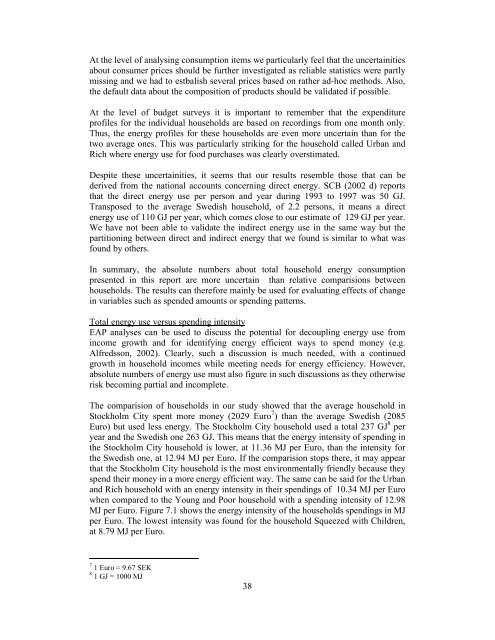Household Metabolism in the Five Cities.
Household Metabolism in the Five Cities.
Household Metabolism in the Five Cities.
You also want an ePaper? Increase the reach of your titles
YUMPU automatically turns print PDFs into web optimized ePapers that Google loves.
At <strong>the</strong> level of analys<strong>in</strong>g consumption items we particularly feel that <strong>the</strong> uncerta<strong>in</strong>ities<br />
about consumer prices should be fur<strong>the</strong>r <strong>in</strong>vestigated as reliable statistics were partly<br />
miss<strong>in</strong>g and we had to estbalish several prices based on ra<strong>the</strong>r ad-hoc methods. Also,<br />
<strong>the</strong> default data about <strong>the</strong> composition of products should be validated if possible.<br />
At <strong>the</strong> level of budget surveys it is important to remember that <strong>the</strong> expenditure<br />
profiles for <strong>the</strong> <strong>in</strong>dividual households are based on record<strong>in</strong>gs from one month only.<br />
Thus, <strong>the</strong> energy profiles for <strong>the</strong>se households are even more uncerta<strong>in</strong> than for <strong>the</strong><br />
two average ones. This was particularly strik<strong>in</strong>g for <strong>the</strong> household called Urban and<br />
Rich where energy use for food purchases was clearly overstimated.<br />
Despite <strong>the</strong>se uncerta<strong>in</strong>ities, it seems that our results resemble those that can be<br />
derived from <strong>the</strong> national accounts concern<strong>in</strong>g direct energy. SCB (2002 d) reports<br />
that <strong>the</strong> direct energy use per person and year dur<strong>in</strong>g 1993 to 1997 was 50 GJ.<br />
Transposed to <strong>the</strong> average Swedish household, of 2.2 persons, it means a direct<br />
energy use of 110 GJ per year, which comes close to our estimate of 129 GJ per year.<br />
We have not been able to validate <strong>the</strong> <strong>in</strong>direct energy use <strong>in</strong> <strong>the</strong> same way but <strong>the</strong><br />
partition<strong>in</strong>g between direct and <strong>in</strong>direct energy that we found is similar to what was<br />
found by o<strong>the</strong>rs.<br />
In summary, <strong>the</strong> absolute numbers about total household energy consumption<br />
presented <strong>in</strong> this report are more uncerta<strong>in</strong> than relative comparisions between<br />
households. The results can <strong>the</strong>refore ma<strong>in</strong>ly be used for evaluat<strong>in</strong>g effects of change<br />
<strong>in</strong> variables such as spended amounts or spend<strong>in</strong>g patterns.<br />
Total energy use versus spend<strong>in</strong>g <strong>in</strong>tensity<br />
EAP analyses can be used to discuss <strong>the</strong> potential for decoupl<strong>in</strong>g energy use from<br />
<strong>in</strong>come growth and for identify<strong>in</strong>g energy efficient ways to spend money (e.g.<br />
Alfredsson, 2002). Clearly, such a discussion is much needed, with a cont<strong>in</strong>ued<br />
growth <strong>in</strong> household <strong>in</strong>comes while meet<strong>in</strong>g needs for energy efficiency. However,<br />
absolute numbers of energy use must also figure <strong>in</strong> such discussions as <strong>the</strong>y o<strong>the</strong>rwise<br />
risk becom<strong>in</strong>g partial and <strong>in</strong>complete.<br />
The comparision of households <strong>in</strong> our study showed that <strong>the</strong> average household <strong>in</strong><br />
Stockholm City spent more money (2029 Euro 7 ) than <strong>the</strong> average Swedish (2085<br />
Euro) but used less energy. The Stockholm City household used a total 237 GJ 8 per<br />
year and <strong>the</strong> Swedish one 263 GJ. This means that <strong>the</strong> energy <strong>in</strong>tensity of spend<strong>in</strong>g <strong>in</strong><br />
<strong>the</strong> Stockholm City household is lower, at 11.36 MJ per Euro, than <strong>the</strong> <strong>in</strong>tensity for<br />
<strong>the</strong> Swedish one, at 12.94 MJ per Euro. If <strong>the</strong> comparision stops <strong>the</strong>re, it may appear<br />
that <strong>the</strong> Stockholm City household is <strong>the</strong> most environmentally friendly because <strong>the</strong>y<br />
spend <strong>the</strong>ir money <strong>in</strong> a more energy efficient way. The same can be said for <strong>the</strong> Urban<br />
and Rich household with an energy <strong>in</strong>tensity <strong>in</strong> <strong>the</strong>ir spend<strong>in</strong>gs of 10.34 MJ per Euro<br />
when compared to <strong>the</strong> Young and Poor household with a spend<strong>in</strong>g <strong>in</strong>tensity of 12.98<br />
MJ per Euro. Figure 7.1 shows <strong>the</strong> energy <strong>in</strong>tensity of <strong>the</strong> households spend<strong>in</strong>gs <strong>in</strong> MJ<br />
per Euro. The lowest <strong>in</strong>tensity was found for <strong>the</strong> household Squeezed with Children,<br />
at 8.79 MJ per Euro.<br />
7 1 Euro = 9.67 SEK<br />
8 1 GJ = 1000 MJ<br />
38
















